|
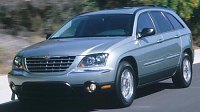 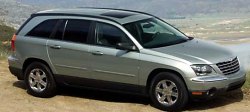 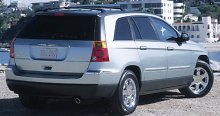
Following
Crossfire, Chrysler Pacifica is another product engineered mostly by
Mercedes-Benz
in Germany. Such product development strategy helps improving the
quality
of Chrysler products while reducing cost through sharing components
with
its mother company. As long as the cars are good and reasonably priced,
customers don't care where the car is engineered.
The
Pacifica is
developed
by the same team who is currently engineering the Mercedes R-class.
This
imply that both cars share the same architecture, such as the front
MacPherson
strut and rear 5-link suspensions, the latter is taken from Mercedes
E-class.
Engine and transmission, however, come from Detroit. It is powered by
Chrysler
300M's 3.5-litre V6, good for 250hp and 250lbft, and drive through the
familiar 4-speed automatic with "AutoStick" manual-override
function.
Both
Pacifica and
Mercedes
R-class are cross-over vehicle - half-SUV, half-wagon. DaimlerChrysler
believe car buyers love the high driving position and security feel of
SUV but also the ride and handling of regular cars. Thanks to the
high-spec
suspensions, the Pacifica really rides as smooth as a regular sedan. It
also controls body movement pretty tidily, but the limiting factor is
the
hefty kerb weight of 2120kg, actually matching a real SUV. 5-meter
length
and 2-meter width also make it feel bulkier than a regular sedan.
Off-road
handling matches the like of BMW X5 and Volvo XC90 in most conditions,
thanks to a simple but effective viscous-coupling 4WD system.
With 2.1 ton
to
pull, the
3.5 V6 feels short of power. 0-60mph takes an estimated 9.5 seconds,
very
slow indeed. The Chrysler V6 is not renowned for refinement, but in
this
application it needs to rev higher thus noise problem is particularly
serious.
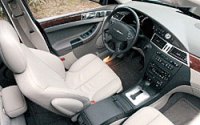 The
interior of Pacifica meets almost the standard of Mercedes-Benz
(admittedly,
this is partly because Mercedes' own standard has dropped a lot in the
past few years). In fact, the Pacifica uses many Mercedes components,
such
as the seat adjustment control mounted on the doors. Plastic material
is
the best we have seen in a Chrysler. Fit and finish is very good. This
is the biggest surprise of the car. The
interior of Pacifica meets almost the standard of Mercedes-Benz
(admittedly,
this is partly because Mercedes' own standard has dropped a lot in the
past few years). In fact, the Pacifica uses many Mercedes components,
such
as the seat adjustment control mounted on the doors. Plastic material
is
the best we have seen in a Chrysler. Fit and finish is very good. This
is the biggest surprise of the car.
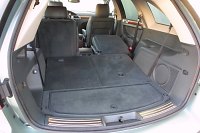 The
interior is big, but it offers just 6 seats, not very efficient for a
car
so big and heavy. The 6 seats are distributed evenly in 3 rows. The
first
2 rows have plenty of head, leg and shoulder room. The 3rd row has
limited
legroom thus is more suitable for short passengers or children. The
last
2 rows can fold flat onto the floor to load cargo. However, no matter
cargo-carrying
capacity or the flexibility of seating cannot match a real MPV, not
even
Volvo XC90. For example, if you need to take 5 people, one of them has
to tolerate the cramped last row. If you need to take some more luggage
than the limited cargo space in the 6-seat configuration, you must fold
down the third row and then you get only 4 seats left. In contrast,
XC90
and all MPVs offer the more useful 2+3+2 configuration. The
interior is big, but it offers just 6 seats, not very efficient for a
car
so big and heavy. The 6 seats are distributed evenly in 3 rows. The
first
2 rows have plenty of head, leg and shoulder room. The 3rd row has
limited
legroom thus is more suitable for short passengers or children. The
last
2 rows can fold flat onto the floor to load cargo. However, no matter
cargo-carrying
capacity or the flexibility of seating cannot match a real MPV, not
even
Volvo XC90. For example, if you need to take 5 people, one of them has
to tolerate the cramped last row. If you need to take some more luggage
than the limited cargo space in the 6-seat configuration, you must fold
down the third row and then you get only 4 seats left. In contrast,
XC90
and all MPVs offer the more useful 2+3+2 configuration.
Pacifica
is not a
bad car,
but if it could be lighter, faster, quieter, more efficient and more
flexible,
it would have won our love. It is just not good enough.
|